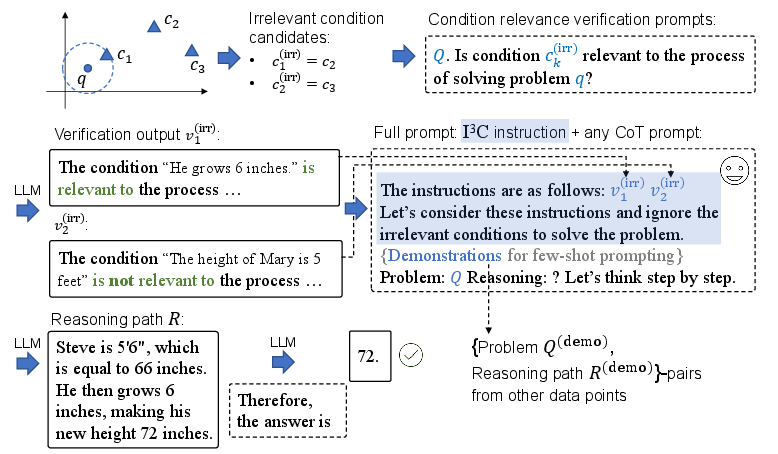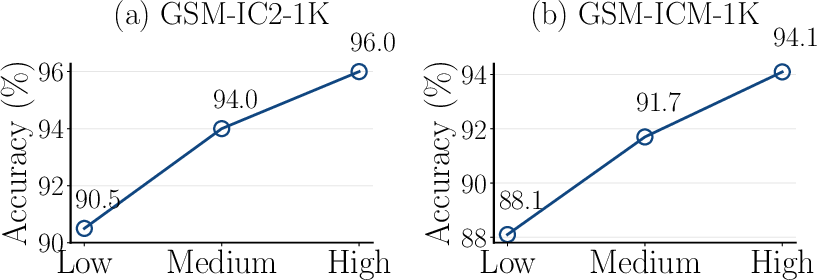- The paper introduces I3C, a method instructing LLMs to detect and ignore irrelevant conditions, leading to more accurate reasoning in math word problems.
- It describes a three-step process of candidate identification, verification, and instruction integration, validated across eight MWP datasets.
- I3C-Select optimizes demonstration selection by choosing high-confusion problems, reducing computational costs while maintaining high accuracy.
Instructing LLMs to Ignore Irrelevant Conditions
The paper "Instructing LLMs to Identify and Ignore Irrelevant Conditions" (2403.12744) introduces I3C, a novel approach designed to enhance LLM performance in solving MWPs. The key innovation involves instructing LLMs to explicitly identify and ignore irrelevant conditions, which often confuse existing CoT prompting methods. The paper demonstrates that by incorporating I3C, LLMs can generate more accurate reasoning paths and achieve state-of-the-art results across a range of MWP datasets.
I3C Methodology
The I3C approach comprises three main steps: identifying irrelevant condition candidates, verifying their irrelevance, and leveraging these verifications to guide the LLM's reasoning process (Figure 1).


Figure 1: Existing CoT prompting methods were confused by irrelevant conditions in math word problems and gave wrong answers.
Initially, the method splits a MWP into individual conditions {ci} and a question sentence q. A pre-trained LLM, such as SimCSE, encodes these conditions and the question into vector representations, {ci} and q, respectively. The semantic relevance between each condition ci and the question q is then quantified using cosine similarity, si(c) and si(q).
Conditions with low semantic relevance (i.e., si(c)<θ or si(q)<θ) are flagged as irrelevant condition candidates, forming the set I={ck(irr)}. The threshold θ is a hyperparameter that controls the sensitivity of the irrelevance detection.
Next, an LLM is prompted to verify whether each candidate condition ck(irr) is indeed irrelevant. The verification prompt takes the form: “Q. Is condition $c_{k^{(\mathrm{irr})}$ relevant to the process of solving problem q?" The LLM's response, vk(irr), provides a justification for the relevance or irrelevance of the condition.
Finally, the verification outputs {vk(irr)} are combined to create the I3C instruction, denoted by I. This instruction is then prepended to any CoT prompting method, guiding the LLM to focus on relevant information and ignore irrelevant details.
Enhancements with I3C-Select
To further enhance the performance of I3C, the authors introduce I3C-Select, a few-shot prompting method that automatically selects the most confusing problems as demonstrations. The confusion score of a problem Q is defined as the inverse of the average similarity between its conditions and the question:
conf(Q)=[n1i=1∑ncos(ci,q)]−1
The K problems with the highest confusion scores are selected, and their reasoning paths are generated using the Zero-Shot-CoT prompting method. These confusing problems and their reasoning paths serve as demonstrations for the LLM, enabling it to better handle complex scenarios with irrelevant conditions.
Experimental Evaluation and Results
The effectiveness of I3C and I3C-Select was evaluated on eight MWP datasets, including AddSub, SVAMP, GSM8K, SingleEq, GSM-IC2-1K, GSM-ICM-1K, AQuA, and MATH. The experiments demonstrate that adding the I3C instruction to CoT prompting methods significantly improves their performance. For example, adding I3C instruction to Manual-CoT improves the accuracy by +8.1 on AddSub, +8.1 on SVAMP, +6.0 on GSM8K, +5.1 on SingleEq, +5.1 on GSM-IC2-1K, +2.8 on AQuA, +9.2 on MATH, and +7.8 on GSM-ICM-1K. The most striking results were observed on datasets with a high proportion of irrelevant conditions, such as GSM-IC2-1K and GSM-ICM-1K. On these datasets, I3C-Select achieved accuracy gains of +11.7 and +11.1, respectively, compared to the Complex-CoT method.

Figure 2: Performance comparison of Complex-CoT, Complex-CoT with I3C instruction (i.e., Complex-CoT+I3C), and Complex-CoT with self-consistency (i.e., Complex-CoT-Self-Consistency). We can observe that the accuracy of Complex-CoT+I3C and Complex-CoT-Self-Consistency is nearly identical, while Complex-CoT+I3C consumes much less tokens and time than Complex-CoT-Self-Consistency.
The authors also compared the performance of Complex-CoT with I3C (Complex-CoT+I3C) against Complex-CoT with self-consistency (Complex-CoT-Self-Consistency). The results showed that Complex-CoT+I3C achieved nearly identical accuracy to Complex-CoT-Self-Consistency, while consuming significantly fewer tokens and time (Figure 2). This highlights the efficiency and effectiveness of the I3C approach.

Figure 3: Demonstration construction methods comparison. Low'' indicates selecting eight problems with the lowest confusion scores.Medium'' indicates randomly selecting eight problems. ``High'' indicates selecting eight problems with the highest confusion scores.
Ablation studies were conducted to evaluate the impact of different demonstration construction methods on the performance of I3C-Select. The results demonstrated that selecting the most confusing problems as demonstrations ("High") consistently outperformed selecting problems with the lowest confusion scores ("Low") or randomly selecting problems ("Medium") (Figure 3). This finding supports the hypothesis that focusing on the most challenging examples can effectively improve the LLM's ability to handle irrelevant conditions.

Figure 4: Hyperparameter analysis. (a) As the threshold increases, the recall scores of identified irrelevant condition candidates first increase and then remain unchanged for all datasets except SingleEq. (b) As the threshold increases, the percentage of conditions to be verified first increases and then remains unchanged for all datasets.
Hyperparameter analysis was performed to determine the optimal threshold θ for identifying irrelevant condition candidates. The results indicated that a threshold of $0.5$ provided a good balance between the recall of irrelevant conditions and the percentage of conditions requiring verification (Figure 4).
Implications and Future Directions
The I3C approach has significant implications for the development of more robust and reliable LLMs. By explicitly addressing the issue of irrelevant conditions, I3C enables LLMs to generate more accurate reasoning paths and improve their performance on complex problem-solving tasks. The plug-and-play nature of the I3C module makes it easy to integrate into existing CoT prompting methods, providing a versatile tool for enhancing LLM capabilities.
Future research directions could explore the application of I3C to other NLP tasks that are susceptible to irrelevant information, such as question answering and text summarization. Additionally, investigating the use of more sophisticated methods for identifying irrelevant conditions, such as employing more advanced semantic similarity measures or training dedicated irrelevance detection models, could further improve the performance of I3C.
Conclusion
The paper "Instructing LLMs to Identify and Ignore Irrelevant Conditions" (2403.12744) presents a valuable contribution to the field of LLMs. The I3C approach offers a practical and effective solution for mitigating the negative impact of irrelevant conditions on MWP solving performance. The experimental results demonstrate the superiority of I3C and I3C-Select over existing prompting methods, highlighting the potential of explicit instruction for enhancing LLM reasoning abilities.






